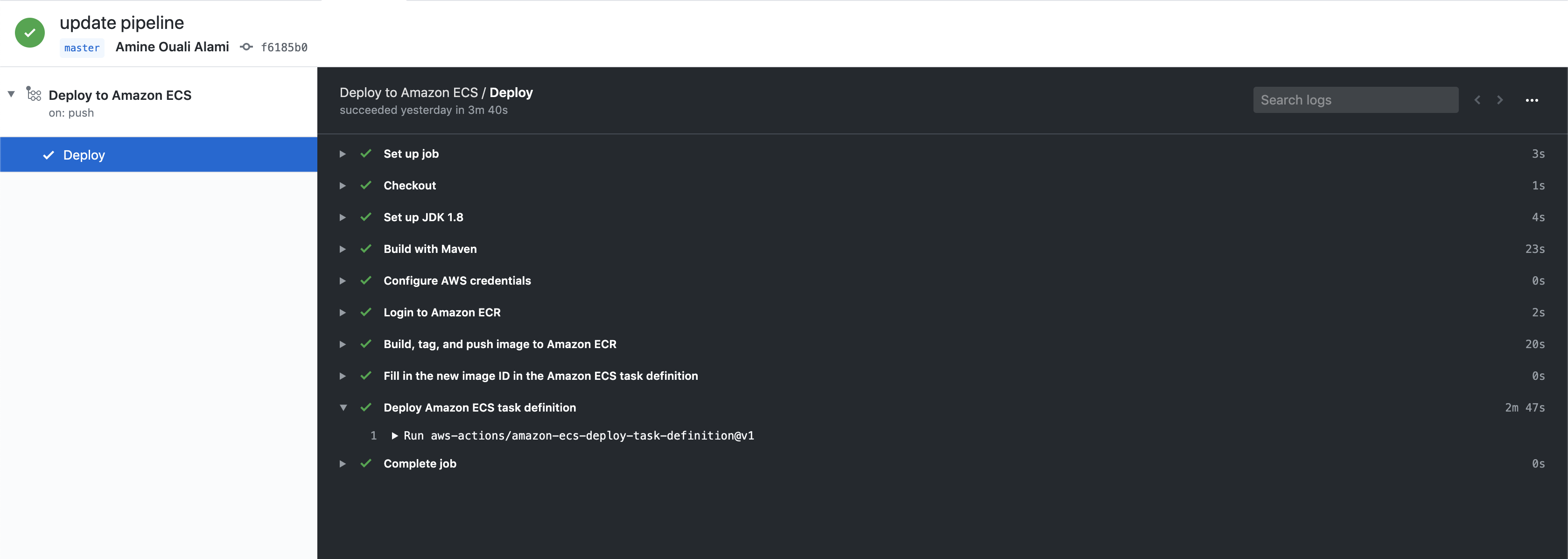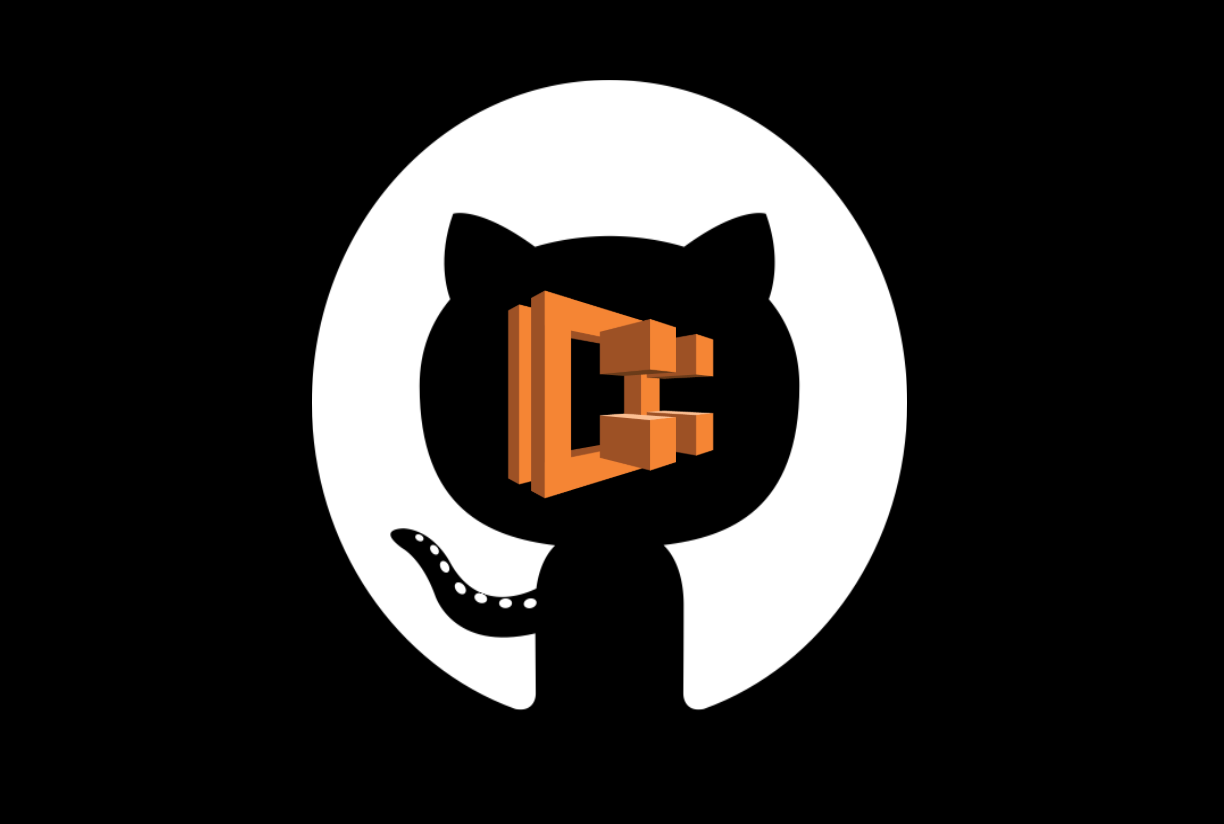That's why tech giants are trying to integrate all pipeline steps into their platforms. In this article, we will deploy a simple Spring Boot application to Amazon Elastic Container Service (ECS) using the new GitHub feature called GitHub Actions.
What is GitHub Actions?
GitHub Actions enables you to create custom software development lifecycle pipelines directly in your GitHub repository.
You can write individual tasks, called "actions" and combine them to create a custom pipeline.
Behind the scenes, your pipeline is run on GitHub-hosted machines, called "runners".
Create Your First Pipeline With Github Actions
On your GitHub repository select the Actions tab.
GitHub proposes popular pipelines to start with. We will choose: Deploy to Amazon ECS

It will add a file to your repository (/.github/workflows/aws.yml) that represents your GitHub Actions.
We add two more steps to set up the JDK 8 and the maven command to build the Spring Boot JAR file.
on:
push:
branches:
- master
name: Deploy to Amazon ECS
jobs:
deploy:
name: Deploy
runs-on: ubuntu-latest
steps:
- name: Checkout
uses: actions/checkout@v1
- name: Set up JDK 11
uses: actions/setup-java@v1
with:
java-version: 11
- name: Build with Maven
run: mvn clean install
- name: Configure AWS credentials
uses: aws-actions/configure-aws-credentials@v1
with:
aws-access-key-id: ${{ secrets.AWS_ACCESS_KEY_ID }}
aws-secret-access-key: ${{ secrets.AWS_SECRET_ACCESS_KEY }}
aws-session-token: ${{ secrets.AWS_SESSION_TOKEN }}
aws-region: us-east-2
- name: Login to Amazon ECR
id: login-ecr
uses: aws-actions/amazon-ecr-login@v1
- name: Build, tag, and push image to Amazon ECR
id: build-image
env:
ECR_REGISTRY: ${{ steps.login-ecr.outputs.registry }}
ECR_REPOSITORY: dcdojo-amine
IMAGE_TAG: ${{ github.sha }}
run: |
# Build a docker container and
# push it to ECR so that it can
# be deployed to ECS.
docker build -t $ECR_REGISTRY/$ECR_REPOSITORY:$IMAGE_TAG .
docker push $ECR_REGISTRY/$ECR_REPOSITORY:$IMAGE_TAG
echo "::set-output name=image::$ECR_REGISTRY/$ECR_REPOSITORY:$IMAGE_TAG"
- name: Fill in the new image ID in the Amazon ECS task definition
id: task-def
uses: aws-actions/amazon-ecs-render-task-definition@v1
with:
task-definition: task-definition.json
container-name: dcdojo-container
image: ${{ steps.build-image.outputs.image }}
- name: Deploy Amazon ECS task definition
uses: aws-actions/amazon-ecs-deploy-task-definition@v1
with:
task-definition: ${{ steps.task-def.outputs.task-definition }}
service: dc-dojo-service-github
cluster: dcdojo-cluster
wait-for-service-stability: true
This pipeline will checkout the code, build the JAR file, build and push the Docker image to Amazon Elastic Container Registry (ECR), and then deploy a new task definition to Amazon ECS on every push to the master branch.
Before using this pipeline, you will need to complete all the necessary infrastructure configuration on AWS:
- Create an ECS repository
- Create an ECS task definition, an ECS cluster, and an ECS service. ECS getting started
- Store your ECS task definition as a Json file in your repository
The task-definition used in that project:
task-definition.json
{
"family": "dcdojo",
"executionRoleArn": "arn:aws:iam::112233445566:role/ecsTaskExecutionRole",
"containerDefinitions": [
{
"name": "dcdojo-container",
"image": "112233445566.dkr.ecr.us-east-2.amazonaws.com/dcdojo-amine:4622390a2b34f72y5f389cb62128a305641942cd",
"cpu": 512,
"portMappings": [
{
"hostPort": 8888,
"protocol": "tcp",
"containerPort": 8888
}
],
"memory": 1024,
"essential": true,
"logConfiguration": {
"logDriver": "awslogs",
"options": {
"awslogs-group": "/ecs/dcdojo",
"awslogs-region": "us-east-2",
"awslogs-stream-prefix": "ecs"
}
}
}
],
"requiresCompatibilities": [
"FARGATE"
],
"networkMode": "awsvpc",
"cpu": "1024",
"memory": "2048"
}
and a Dockerfile:
FROM openjdk:8-jdk-alpine
RUN apk --no-cache add curl
VOLUME /tmp
EXPOSE 8888
ADD target/dcdojo-0.0.1-SNAPSHOT.jar app.jar
ENTRYPOINT ["java","-Djava.security.egd=file:/dev/./urandom","-jar","app.jar"]
After running this pipeline, the results looks like:

Conclusion
GitHub is actively working to integrate all necessary DevOps features in their platform such as GitHub Package, which stores your artifacts, and security alerts that track security vulnerabilities that apply to your project dependencies (Software Composition Analysis).
If you are using GitHub at an enterprise level or hosting an open-source project, these new features can be a serious alternative to the classic DevOps toolkit.



Comments